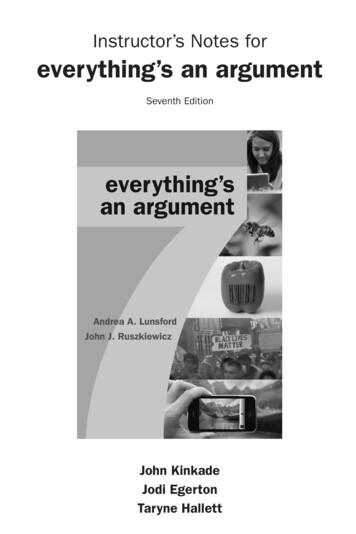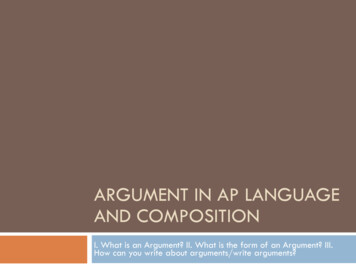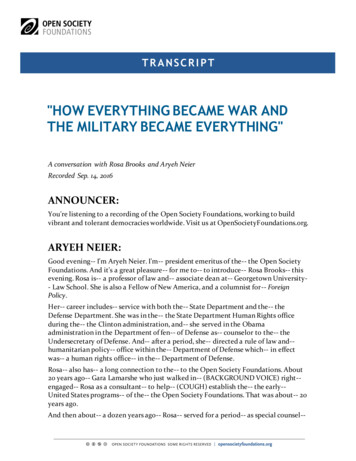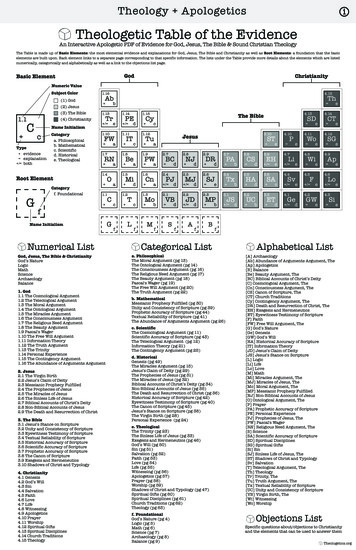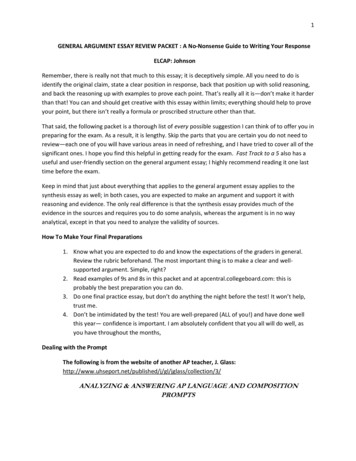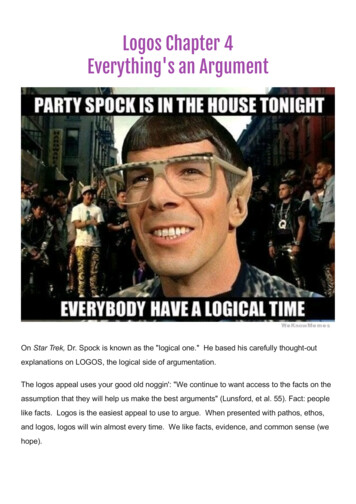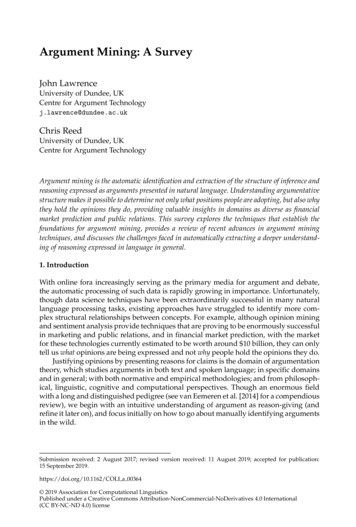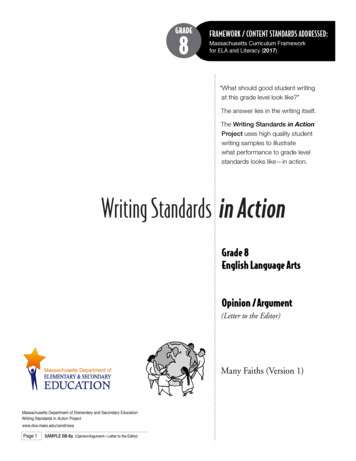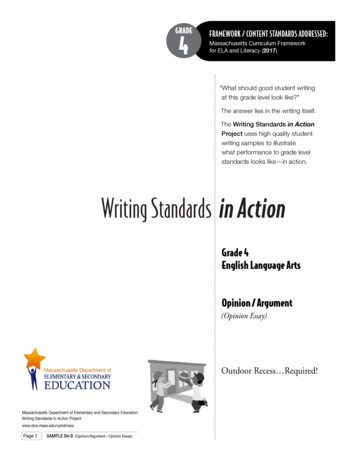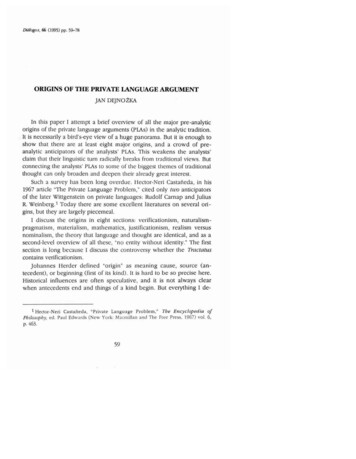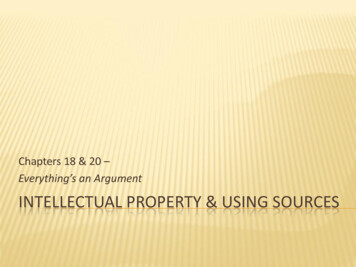
Transcription
Chapters 18 & 20 –Everything’s an ArgumentINTELLECTUAL PROPERTY & USING SOURCES
SOURCES THAT DON’T NEED TO BE ACKNOWLEDGED(REPRISE)Common knowledge – specific information thatmost readers will know Facts available from a wide variety of sources(the date of the bombing of Pearl Harbor, forexample) Your own findings from field research shouldbe simple announced as your own EVERYTHING ELSE MUST BE DOCUMENTED!!
CREDITING SOURCES IN ARGUMENTSGiving full credit to your sources enhances yourethos Demonstrates you’ve done your homework Understand what others have written Encourages others to join the conversation Reminds you to think critically about how wellyou’ve used them
CITING SOURCES AND RECOGNIZING PLAGIARISM Most of what you think or write is based on what you’vealready read or experiencedMust acknowledge any intellectual property you’veborrowed to create argumentsNo acknowledgementPlagiarism
CITING SOURCES AND RECOGNIZING PLAGIARISMWhy is this so important?Western culture views using someone else’slanguage and ideas without acknowledgement asdishonest.
CITING SOURCES AND RECOGNIZING PLAGIARISMHCC Policy:Instances of plagiarism on 2 major assignments willresult in an “F” for the course.Industry: You lose you credibility and your job
THIS IS PLAGIARISMBuying, stealing, or borrowing a paper(including, of course, copying an entire paper orarticle from the Web); Hiring someone to write your paper for you; and Copying large sections of text from a sourcewithout quotation marks or proper citation. http://owl.english.purdue.edu/owl/resource/563/1/
INACCURATE OR INCOMPLETE CITATION SOURCESYou may be accused of plagiarism if: Your paraphrase is too close to the original wording You leave out the parenthetical reference for aquotationIncorrect: “TheCorrect: “Therich are different from you and me.”rich are different from you and me”(Fitzgerald).
PLAGIARISM – GRAY AREA You build on someone's ideas without citing theirspoken or written work.Sometimes teachers suspecting students of plagiarismwill consider the students' intent, and whether itappeared the student was deliberately trying tomake ideas of others appear to be his or her own.However, other teachers and administrators may notdistinguish between deliberate and accidentalplagiarism.
WHEN DO YOU GIVE CREDIT? Words or ideas presented in a magazine, book, newspaper,song, TV program, movie, Web page, computer program,letter, advertisement, or any other mediumInformation you gain through interviewing or conversingwith another person, face to face, over the phone, or inwritingWhen you copy the exact words or a unique phraseWhen you reprint any diagrams, illustrations, charts,pictures, or other visual materialsWhen you reuse or repost any electronically-availablemedia, including images, audio, video, or other media
WHEN DO YOU GIVE CREDITDocument any words, ideas, or other productionsthat originate somewhere outside of you.
CERTAIN THINGS THAT DO NOT NEED DOCUMENTATION Writing your own lived experiences, your own observationsand insights, your own thoughts, and your own conclusionsabout a subjectWhen you are writing up your own results obtained throughlab or field experimentsWhen you use your own artwork, digital photographs, video,audio, etc.When you are using "common knowledge," things like folklore,common sense observations, myths, urban legends, andhistorical events (but not historical documents)When you are using generally-accepted facts, e.g., pollution isbad for the environment, including facts that are acceptedwithin particular discourse communities, e.g., in the field ofcomposition studies, "writing is a process" is a generallyaccepted fact.
DECIDING IF SOMETHING IS "COMMON KNOWLEDGE"if you find the same information undocumentedin at least five credible sources. if you think the information you're presenting issomething your readers will already know, orsomething that a person could easily find ingeneral reference sources. when in doubt, cite; if the citation turns out tobe unnecessary, your teacher or editor will tellyou.
QUOTATIONS, PARAPHRASES, AND SUMMARIESThese three ways of incorporating other writers'work into your own writing differ according tothe closeness of your writing to the sourcewriting.Always cite these!
WHY USE QUOTATIONS, PARAPHRASES, ANDSUMMARIES? Provide support for claims or add credibility to yourwritingRefer to work that leads up to the work you are now doingGive examples of several points of view on a subjectCall attention to a position that you wish to agree ordisagree withHighlight a particularly striking phrase, sentence, orpassage by quoting the originalDistance yourself from the original by quoting it in orderto cue readers that the words are not your ownExpand the breadth or depth of your writing
WHAT’S THE DIFFERENCE?Quotations must be identical to the original, usinga narrow segment of the source. They mustmatch the source document word for word andmust be attributed to the original author.Quotations should be used sparingly!
WHAT’S THE DIFFERENCE?Paraphrasing involves putting a passage fromsource material into your own words. Must also be attributed to the original source. Paraphrased material is usually shorter than theoriginal passage, taking a somewhat broadersegment of the source and condensing it slightly.
WHAT’S THE DIFFERENCE?Summarizing involves putting the main idea(s) intoyour own words, including only the mainpoint(s). Once again, it is necessary to attributesummarized ideas to the original source.Summaries are significantly shorter than theoriginal and take a broad overview of the sourcematerial.
HOW TO USE QUOTATIONS, PARAPHRASES, ANDSUMMARIESRead the entire text, noting the key points andmain ideas. Summarize in your own words what the singlemain idea of the essay is. Paraphrase important supporting points thatcome up in the essay. Consider any words, phrases, or brief passagesthat you believe should be quoted directly.
QUOTE INTEGRATIONshort quotations work well when integrated intoa sentence. Longer quotations can stand alone.Quoting should be done only sparingly be sure that you have a good reason to include adirect quotation when you decide to do so.
USING SOURCES Youmay want to introduce important sourcesin your text. Be sure to identify theirsignificance. (“Noted child psychologistDorothea Brooke said ”) You can subtly influence the credibility of thequote via signal verb choice:Dr. Brooke said, “children need love.”According to Dr. Brooke, “children need love”Dr. Brooke believes that children need love.
USING SOURCES: SIGNAL VERBS Acknowledges, advises, agrees, allows, asserts, believes, charges,claims, concurs, criticizes, declares, disagrees, discusses, disputes,emphasizes, expresses, lists, objects, observes, offers, opposes,remarks, replies, responds, states, suggests “Dr. Brooke thinks that children need love”“Dr. Brooke interprets the data to mean that childrenneed love”“Dr. Brooke concluded that children need love”“Dr. Brooke reveals that children need love”“Dr. Brooke confirms that children need love”
PUNCTUATING QUOTATIONSUse brackets around material that you insert Enclose quotations in quotation marks MollyGibson said that “the award [was] a greathonor for [her].” Use ellipses to indicate omitted material “Howdo I love thee? I love thee with the breath,smiles, tears of all my life ”
PUNCTUATING QUOTATIONS II Commas and periods go inside the closing quotationmarks; question marks, semi-colons, colons, andexclamation points are placed according to the logic ofthe sentence Do you know how to sing “God Save the Queen”?People always ask me, “How do you keep your garden inbloom all year round?”Bart exclaimed, “¡Ay, caramba!”Then the jerk told me he “needed more space”!Quotations are enclosed in double quotes; quotationsembedded within quotations are indicated by singlequotes She said, “This so-called ‘free and fair’ election is a travesty ofjustice.”
IN-TEXT CITATIONS
AUTHOR-PAGE STYLEIn-text Example:Wordsworth stated that Romantic poetry was marked by a "spontaneousoverflow of powerful feelings" (263).Romantic poetry is characterized by the "spontaneous overflow ofpowerful feelings" (Wordsworth 263). Wordsworth extensively exploredthe role of emotion in the creative process (263).Corresponding Works Cited Entry:Wordsworth, William. Lyrical Ballads. London: OxfordU.P., 1967. Print.
WITH UNKNOWN AUTHORIn-text Example:We see so many global warming hotspots in North America likelybecause this region has “more readily accessible climatic data andmore comprehensive programs to monitor and studyenvironmental change . . .” (“Impact of Global Warming” 6).Corresponding Works Cited Entry:“The Impact of Global Warming in North America.”GLOBAL WARMING: Early Signs. 1999. Web. 23 Mar.2009.
OTHER IN-TEXT CITATIONS 1Authors with Same Last NamesIn-text Example:Although some medical ethicists claim that cloning will lead todesigner children (R. Miller 12), others note that the advantagesfor medical research outweigh this consideration (A. Miller 46).
OTHER IN-TEXT CITATIONS 2Work by Multiple AuthorsIn-text Examples:Smith, Yang, and Moore argue that tougher gun control is notneeded in the United States (76).The authors state "Tighter gun control in the United States erodesSecond Amendment rights" (Smith, Yang, and Moore 76).Jones et al. counter Smith, Yang, and Moore's argument by notingthe current spike in gun violence in America compels law makersto adjust gun laws (4).
OTHER IN-TEXT CITATIONS 3Multiple Works by the Same AuthorIn-text Examples:Lightenor has argued that computers are not useful tools for smallchildren ("Too Soon" 38), though he has acknowledged elsewherethat early exposure to computer games does lead to better smallmotor skill development in a child's second and third year ("HandEye Development" 17).Visual studies, because it is such a new discipline, may be "tooeasy" (Elkins, "Visual Studies" 63).
OTHER IN-TEXT CITATIONS 4Citing the BibleIn-text Example:Ezekiel saw "what seemed to be four living creatures,"each with faces of a man, a lion, an ox, and an eagle(New Jerusalem Bible, Ezek. 1.5-10).
OTHER IN-TEXT CITATIONS 7Sources from the InternetIn-text Example:One online film critic stated that Fitzcarraldo is ".a beautiful andterrifying critique of obsession and colonialism" (Garcia,“Herzog: a Life”).Corresponding Works Cited Entry:Garcia, Elizabeth. "Herzog: a Life." Online Film CriticsCorner. The Film School of New Hampshire, 2 May2002. Web. 8 Jan. 2009.
FORMATTING LONG QUOTATIONSIn-text Example:Nelly Dean treats Heathcliff poorly and dehumanizes him throughout hernarration:They entirely refused to have it in bed with them, or even in their room,and I had no more sense, so, I put it on the landing of the stairs, hopingit would be gone on the morrow. By chance, or else attracted by hearinghis voice, it crept to Mr. Earnshaw's door, and there he found it onquitting his chamber. Inquiries were made as to how it got there; I wasobliged to confess, and in recompense for my cowardice andinhumanity was sent out of the house. (Bronte 78)
Works Cited Page: WebExamples:Bernstein, Mark. "10 Tips on Writing the Living Web.”A List Apart: For People Who Make Websites. AList Apart Mag., 16 Aug. 2002. Web. 4 May 2009.Felluga, Dino. Guide to Literary and Critical Theory.Purdue U, 28 Nov. 2003. Web. 10 May 2006."How to Make Vegetarian Chili." eHow.com. eHow,n.d. Web. 24 Feb. 2009.
WORKS CITED PAGE: THE BASICS
FOR MORE INFORMATIONPurdue OWL: http://owl.english.purdue.edu/
Everything's an Argument. SOURES THAT DON'T NEED TO E AKNOWLEDGED . Words or ideas presented in a magazine, book, newspaper, song, TV program, movie, Web page, computer program, . She said, "This so-called 'free and fair' election is a travesty of
